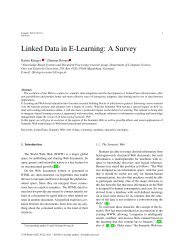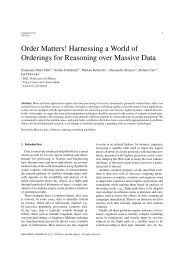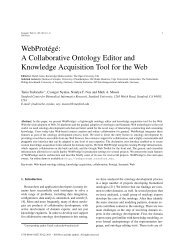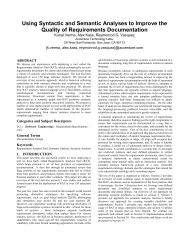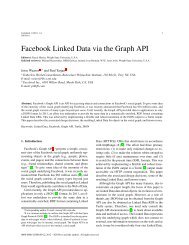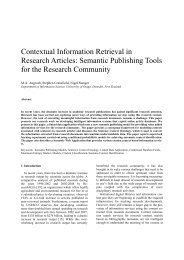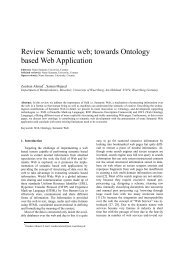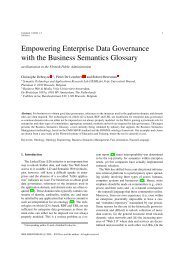A Visual Dashboard for Linked Data - Semantic Web Journal
A Visual Dashboard for Linked Data - Semantic Web Journal
A Visual Dashboard for Linked Data - Semantic Web Journal
Create successful ePaper yourself
Turn your PDF publications into a flip-book with our unique Google optimized e-Paper software.
S. Mazumdar, D. Petrelli and F.Ciravegna / A <strong>Visual</strong> <strong>Dashboard</strong> <strong>for</strong> <strong>Linked</strong> <strong>Data</strong>: An Exploration of User and System Requirements 15can use such framework to quickly explore their owndatasets, shared data or even organizational data. It isalso the familarity of the users with systems followingthe dashboard approach that has influenced our designchoices - the users would not need to be trained in usingdashboards as they almost unknowingly use suchsystems daily (BBC, igoogle, etc).9. ConclusionEveryday more linked data is made available to thepublic <strong>for</strong> consumption, e.g. citizens interested in governmentpolicy or developers of linked data applications.However, there is no generic interface <strong>for</strong> exploringunknown linked data set available today, and,as a matter of fact, only <strong>Semantic</strong> <strong>Web</strong> people couldlook into those repositories and, even them, with difficulties.To be able to create effective interactive visualizations,a deeper and better understanding of the implicationsof the current technical setting and the userrequirements are needed. Our portability experimentswith several different domains indicate that we can use.views. as a generic exploratory tool. This paper is afirst step in this direction: the idea of multiple and simultaneousvisualizations was well received by users,but when the setting effective and efficient on a localdatabase was tested with public SPARQL endpoints(DBpedia) the poor and patchy result push us to reconsidersome design proposals. A <strong>for</strong>mative user evaluationwas carried out in focus group sessions in orderto define which interface features were considered essential.One was the automatic suggestion of possiblevalues <strong>for</strong> selected filters, as this would allow a preexplorationof the available data. However this featureis not available <strong>for</strong> online data sets, due to the slownessand unpredictability of the endpoint reply. A possiblesolution would be to load all the possible unique instancesof a concept during initiation, but the implicationsof this approach <strong>for</strong> a large datasets such as DBpedianeed to be understood. Indeed the type of dataand the technical setting (local vs. endpoints) has asubstantial impact on the user interface. For examplesa data set may not have in<strong>for</strong>mation <strong>for</strong> certain visualizationwidgets, e.g. no date as in the grass data set.A final remark goes to the flexibility of multiple visualizationsavailable to the user. If this on one handis considered very positively on the other could generatemisinterpretation of data if an unsuitable visualizationis applied to a given data set [5,3]. More workis needed to better understand which type of visualizationwould fit which type of linked data so that thevisualization interface could embed those constraintsand reduce the risk of data misinterpretation.10. AcknowledgementsThis research is funded by the Samulet projectfunded by Rolls-Royce plc. and the Technology StrategyBoard. We gratefully acknowledge their support.We thank our focus group attendees <strong>for</strong> their cooperationand extremely helpful suggestions and we aregrateful to the GrassPortal project <strong>for</strong> providing uswith invaluable support.References[1] Christopher Ahlberg, Christopher Williamson, and Ben Shneiderman.Dynamic queries <strong>for</strong> in<strong>for</strong>mation exploration: an implementationand evaluation. In Proceedings of the SIGCHIconference on Human factors in computing systems, CHI ’92,pages 619–626, New York, NY, USA, 1992. ACM.[2] M. Butler, D. Huynh, B. Hyde, R. Lee, and S. Mazzocchi.Longwell project page, 2006.[3] Stephen Few. In<strong>for</strong>mation <strong>Dashboard</strong> Design: The Effective<strong>Visual</strong> Communication of <strong>Data</strong>. Number 3900693099.O’Reilly Media, 2006.[4] J. P Grime. Vegetation classification by reference to strategies.Nature, 250:26 – 31, 1974.[5] Jeffrey Heer, Michael Bostock, and Vadim Ogievetsky. A tourthrough the visualization zoo. Communications of the ACM,53(10.1145/1743546.1743567):59–67, 2010.[6] M. D. Helen Sharp, D. Yvonne Rogers Ph, and M. D.Jenny Preece. Interaction Design: Beyond Human-ComputerInteraction. Wiley, 2 edition, March 2007.[7] Michiel Hildebrand, Jacco van Ossenbruggen, and LyndaHardman. /facet: A Browser <strong>for</strong> Heterogeneous <strong>Semantic</strong> <strong>Web</strong>Repositories. In Isabel Cruz, Stefan Decker, Dean Allemang,Chris Preist, Daniel Schwabe, Peter Mika, Mike Uschold, andLora M. Aroyo, editors, The <strong>Semantic</strong> <strong>Web</strong> - ISWC 2006, volume4273 of Lecture Notes in Computer Science, chapter 20,pages 272–285. Springer Berlin Heidelberg, Berlin, Heidelberg,2006.[8] D. Huynh, S. Mazzocchi, and D. Karger. Piggy bank: Experiencethe semantic web inside your web browser. <strong>Web</strong> <strong>Semantic</strong>s:Science, Services and Agents on the World Wide <strong>Web</strong>,5(1):16–27, March 2007.[9] David F. Huynh, David R. Karger, and Robert C. Miller. Exhibit:lightweight structured data publishing. In Proceedings ofthe 16th international conference on World Wide <strong>Web</strong>, WWW’07, pages 737–746, New York, NY, USA, 2007. ACM.[10] Eero Hyvönen, Eetu Mäkelä, Mirva Salminen, Arttu Valo, KimViljanen, Samppa Saarela, Miikka Junnila, and Suvi Kettula.Museumfinland–finnish museums on the semantic web. <strong>Web</strong><strong>Semantic</strong>s: Science, Services and Agents on the World Wide<strong>Web</strong>, 3(2-3):224 – 241, 2005. Selcted Papers from the International<strong>Semantic</strong> <strong>Web</strong> Conference, 2004 - ISWC, 2004.



